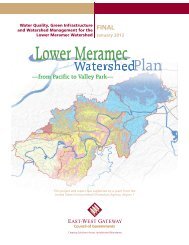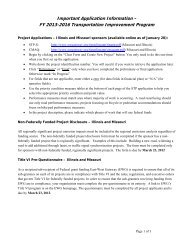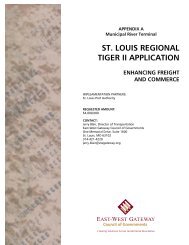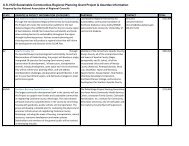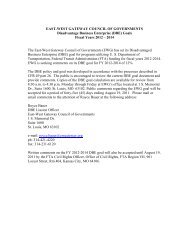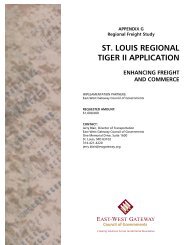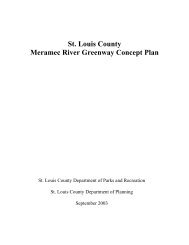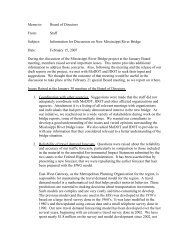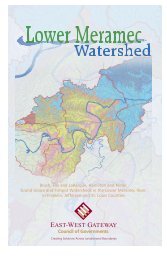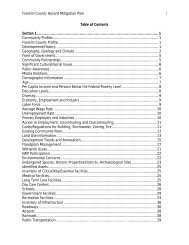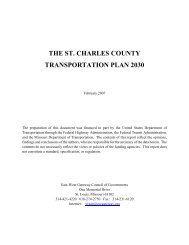Jefferson County - East-West Gateway Coordinating Council
Jefferson County - East-West Gateway Coordinating Council
Jefferson County - East-West Gateway Coordinating Council
Create successful ePaper yourself
Turn your PDF publications into a flip-book with our unique Google optimized e-Paper software.
A Regional Overview All-Hazard Mitigation Plan 79<br />
deficient over an extended period of time, this shortage will be reflected in declining<br />
surface and subsurface water levels. Hydrological drought is associated with the effects of<br />
periods of precipitation (including snowfall) shortfalls on surface or subsurface water<br />
supply (i.e., streamflow, reservoir and lake levels, ground water). The frequency and severity<br />
of hydrological drought is often defined on a watershed or river basin scale. Although all<br />
droughts originate with a deficiency of precipitation, hydrologists are more concerned with<br />
how this deficiency plays out through the hydrologic system. Hydrological droughts are<br />
usually out of phase with or lag the occurrence of meteorological and agricultural<br />
droughts. It takes longer for precipitation deficiencies to show up in components of the<br />
hydrological system such as soil moisture, streamflow, and ground water and reservoir<br />
levels. As a result, these impacts are out of phase with impacts in other economic sectors.<br />
For example, a precipitation deficiency may result in a rapid depletion of soil moisture that<br />
is almost immediately discernible to agriculturalists, but the impact of this deficiency on<br />
reservoir levels may not affect hydroelectric power production or recreational uses for many<br />
months. Also, water in hydrologic storage systems (e.g., reservoirs, rivers) is often used for<br />
multiple and competing purposes (e.g., flood control, irrigation, recreation, navigation,<br />
hydropower, wildlife habitat), further complicating the sequence and quantification of<br />
impacts. Competition for water in these storage systems escalates during drought and<br />
conflicts between water users increase significantly.<br />
Hydrological Drought and Land Use<br />
Although climate is a primary contributor to hydrological drought, other factors such as<br />
changes in land use (e.g., deforestation), land degradation, and the construction of dams<br />
all affect the hydrological characteristics of the basin. Because regions are interconnected<br />
by hydrologic systems, the impact of meteorological drought may extend well beyond the<br />
borders of the precipitation-deficient area. For example, meteorological drought may<br />
severely affect portions of the northern Rocky Mountains and northern Great Plains region<br />
of the United States. However, since the Missouri River and its tributaries drain this region<br />
to the south, there may be significant hydrologic impacts downstream. Similarly, changes<br />
in land use upstream may alter hydrologic characteristics such as infiltration and runoff<br />
rates, resulting in more variable streamflow and a higher incidence of hydrologic drought<br />
downstream. Bangladesh, for example, has shown an increased frequency of water<br />
shortages in recent years because land use changes have occurred within the country and<br />
in neighboring countries. Land use change is one of the ways human actions alter the<br />
frequency of water shortage even when no change in the frequency of meteorological<br />
drought has been observed.<br />
For the purposes of drought response planning, all three categories (meteorologic,<br />
hydrologic and agriculture) can be regarded as equivalent, since each one relates to the<br />
occurrence of drought to water shortfalls in some component of the hydrologic cycle. The<br />
most commonly used drought severity indicators are the Palmer Drought Severity Index<br />
(PDSI) and the Crop Moisture Index. These are published by NOAA and the USDA. The<br />
PDSI is more widely used than any other single indicator. It provides a standardized means<br />
of depicting drought severity throughout the US. It measures the departure of water



